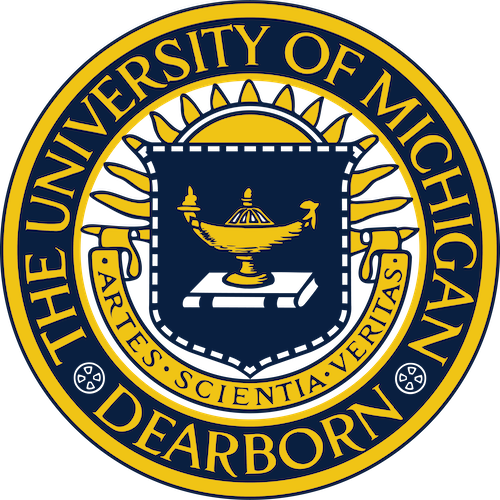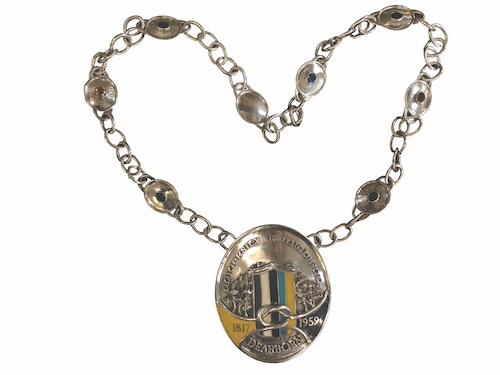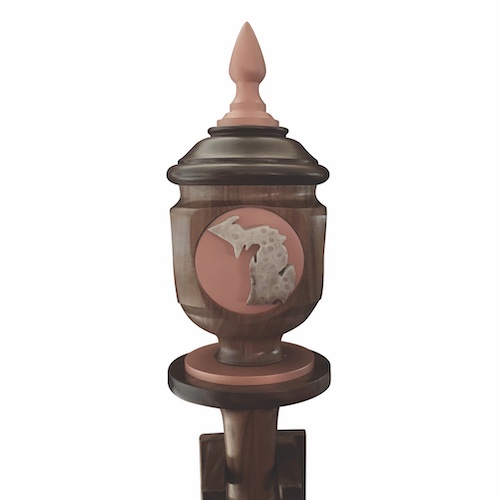University Symbols
University of Michigan-Dearborn Mace
The ceremonial mace is a centuries-old tradition in academia, signifying the knowledge gained and the power that it brings.
To honor this practice and the University of Michigan-Dearborn’s commitment to higher education, a mace is now part of the campus’ 60-year legacy.
The 42-inch mace — will be carried in esteem by the Faculty Senate chairperson during commencement, convocation and other ceremonial events to signify the arrival of the faculty processional.
The UM-Dearborn mace is strong in Michigan representation through its contemporary and purposeful design. It is carved from native wood — walnut, which is prevalently found in the campus’ 300-plus acre Environmental Study Areas — and decorated with Michigan symbols: natural, industrial and educational.
Copper banding — the warm-hued element chosen to signify Michigan’s upper peninsula with the natural resource famously found there — twists around the staff and includes engraved names of top campus leaders throughout the years.
Petoskey stones — fossilized coral fragments from approximately 350 million years ago and found in Michigan’s lower peninsula — adorn the top of the mace, arranged in the shape of the Great Lakes state, representing their status as the state stone and serving as a reminder of the area’s rich history.
Three copper medallions display the strength and partnership of UM-Dearborn’s foundation.
The official campus seal — one with maize enamel and the other with blue enamel — gives homage to university colors and the standard of academic excellence the University of Michigan system upholds. And a third honors the gift from the Ford Motor Co., allowing our higher education institution to take shape in the community and have a positive impact on the people and industries in the state, region and beyond.

The Seal of the University of Michigan-Dearborn is used as a formal insignia on official university documents. The lantern represents liberal learning and symbolizes enlightenment. The banner, “Artes, Scientia, Veritas,” (Arts, Knowledge, Truth) encourages each student to commit to in-depth systematic study, through disciplinary and professional knowledge. The rays of the sun represent personal growth. The outer rings symbolize social responsibility.

The Chancellor’s Medallion is a symbol of the University of Michigan-Dearborn Chain of Office. In the center of the pewter medallion is a raised shield, a design taken from an exterior copper decoration on Fair Lane, the Henry Ford Estate. The wave at the top of the shield represents the Rouge River which runs behind the estate. A knot, superimposed on the shield, symbolizes the connection of the three campuses of the University of Michigan, the connections between the University of Michigan-Dearborn and the community, and the University of Michigan-Dearborn’s urban and suburban constituencies. The background inlay of the shield represents the four schools of the University of Michigan-Dearborn. The University of Michigan appears above the shield; Dearborn appears below. The dates 1817, establishment of the University of Michigan, and 1959, establishment of the University of Michigan-Dearborn, appear on either side. A grove of maple and beech trees, in relief on either side of the shield, represents the University of Michigan-Dearborn’s natural area.

The ceremonial mace is a centuries-old tradition in academia, signifying the knowledge gained and the power that it brings. To honor this practice and the University of Michigan-Dearborn’s commitment to higher education, a mace is now part of the campus’ 60-plus year legacy.
The 42-inch mace will be carried in esteem by a member of the faculty during commencement, convocation and other ceremonial events to signify the arrival of the faculty processional.
The UM-Dearborn mace is strong in Michigan representation through its contemporary and purposeful design. It is carved from native wood — walnut, which is prevalently found in the campus’ 300-plus acre Environmental Study Area — and decorated with Michigan symbols: natural, industrial and educational.
Copper banding — the warm-hued element famously found in Michigan’s upper peninsula — twists around the staff and includes engraved names of top campus leadership throughout the years.
Petoskey stones — fossilized coral fragments from approximately 350 million years ago and found in Michigan’s lower peninsula — adorn the top of the mace, arranged in the shape of the Great Lakes state, representing their status as the state stone and serving as a reminder of the area’s rich history.
Three copper medallions display the strength and partnership of UM-Dearborn’s foundation. The official campus seal — shown on one side with maize enamel and on the other side with blue enamel — gives homage to university colors and the standard of academic excellence the University of Michigan system upholds. And a third honors the gift from the Ford Motor Co., allowing our higher education institution to take shape in the community and have a positive impact on the people and industries in the state, the region and beyond.
